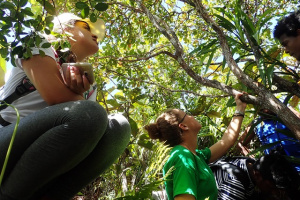Seychelles is filled with plants, but how do you identify them? The website iNaturalist can help
General |Author: Daniel Laurence Edited by: Betymie Bonnelame | September 7, 2019, Saturday @ 09:30| 27986 views
The training included field trips where participants travelled to different locations especially in nature reserves for hands-on experience in plant identification. (Charles Morel)
(Seychelles News Agency) - What's the proper way to identify a plant? Is it by the looking at the flowers, leaves or both?
A recent series of training courses in Seychelles is helping environmental enthusiasts to identify native and non-native plants using an online platform.
During the biological photography session, participants learned how to identify native and non-native plants by using the Seychelles iNaturalist online platform.
“The application assists with species identification. The person must upload a photo and wait for the iNaturalist community to identify it. The iNaturalist system also uses artificial intelligence to provide a preliminary of species,” said Charles Morel, one of the course facilitators.
Participants learnt the importance of taking diagnostic photos -- capturing images of the most useful parts of a plant for identification. They also developed their skills in how to identify plants based on useful pictures of their leaf shape, leaf arrangement on the branch, flower colour, size and fruit among others.
 |
| Participants learnt the importance of taking diagnostic photos. (Charles Morel) Photo License: CC-BY |
The practical session focused on the importance of obtaining good quality pictures and finally using the online platform ‘iNaturalist’ as a tool for citizen science.
The course also provided participants with information on plant groups, available flora, field guides and other identification literature on the Seychelles plants. This included a short introduction on to using the Seychelles Plant Gallery to identify plants to species level.
It also included field trips where participants travelled to different locations especially in nature reserves for hands-on experience in plant identification.
One of the trainers, Belgian Bruno Senterre, a botanical consultant and scientific collaborator to the Seychelles’ herbarium, led the participants in the identification of plant families common to the island nation.
 |
| The training also included field trips where participants travelled to different locations. (Charles Morel) Photo License: CC-BY |
The participants came from environmental protection and conservation organisations from Seychelles, a group of 115 islands in the western Indian Ocean.
“Although most of these organisations are very actively protecting, propagating and creating awareness about plants, they needed to go a step further, that is moving from common names or local names to scientific names, families and genus,” said Morel.
One of the participants Julien Leon from the Praslin-based Terrestrial Restoration Society of Seychelles (Trass) said, “This training really helped us to look at plants from a different perspective. They are not just single plant species, but can be observed as groups with similar characteristics that can be used for identification in the field.”
The sessions did not only provide valuable training but were an opportunity for building relationships and establishing networks among the environmental community.
The training was organised by the Seychelles National Herbarium and Plant Conservation Action (PCA) group through funding from the Critical Ecosystem Partnership Fund (CEPF). The fund is a joint programme of l’Agence Française de Développement, Conservation International, the European Union, the Global Environment Facility, the government of Japan and the World Bank.
Back
